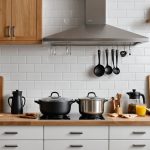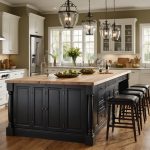Integrating color into your kitchen design can transform an everyday space into a vibrant, inviting area where you can cook, gather, and enjoy. However, it is crucial to approach this task with a careful strategy to avoid overwhelming the space. A small kitchen with bold hues can quickly become chaotic if not executed thoughtfully. With the right balance of colors, textures, and materials, you can create a harmonious and functional environment. This article will guide you on how to effectively incorporate color into your kitchen design while maintaining a sense of openness and tranquility.
Choosing the Right Base Color
The foundation of your kitchen’s color scheme starts with the base color. Opting for a neutral palette, especially white, can set a tranquil tone while allowing you to experiment with other colors. A white backdrop creates a light and airy feel, making the space appear larger and more inviting. It also serves as a blank canvas for adding vibrant accents.
In parallel : What are the benefits of using seasonal ingredients in my cooking?
When integrating color into your kitchen, consider using white or light shades for larger elements such as walls and cabinets. This approach will enhance the natural light in the space, making it feel open and spacious. To add interest and personality, you can incorporate bold colors through accessories, such as tile, artwork, or small appliances.
For those with small kitchens, lighter hues are particularly beneficial. They reflect light and can make the area feel less cramped. However, this doesn’t mean you have to shy away from bold colors altogether. Instead, you can create depth by mixing various shades of blue, green, or other colors you love. A well-chosen accent wall can provide a striking focal point without overpowering the overall design. By thoughtfully selecting your base color, you create a balanced environment that can accommodate bursts of vibrant colors without feeling overwhelming.
Also read : What are the advantages of a kitchen island versus a traditional dining table?
Incorporating Color Through Cabinets
Cabinets are one of the most significant components of your kitchen design, and painting them is an incredible way to add color. If you prefer a more bold look, consider painting your cabinets in a rich blue or a refreshing green. These colors can energize the room and serve as a stunning contrast to white or light-colored walls.
When choosing cabinet colors, think about how they will interact with the other elements in your kitchen. If you opt for bold cabinets, balance them with lighter surroundings. For example, pairing deep blue cabinets with white countertops and a light backsplash can create an eye-catching yet balanced design.
If you’re not ready to commit to a complete overhaul, you can start by painting just the lower or upper cabinets. This technique allows you to introduce color gradually and observe how it impacts the space. Additionally, consider using different colors for upper and lower cabinets for a chic two-tone effect. This method adds visual interest and can make your kitchen feel larger by drawing the eye upward.
Finally, don’t forget about cabinet hardware. Opting for bold handles or knobs in defined colors can serve as a perfect complement to your painted cabinets, enhancing the overall aesthetic. With careful consideration and creativity, your cabinets can become a standout feature in your kitchen’s design.
Using Accessories to Add Color
Accessories are a powerful and versatile way to incorporate color into your kitchen design. From kitchen towels and rugs to decorative bowls and vases, these elements allow you to experiment with various colors without committing to permanent changes.
Start small. Introduce color through textiles such as dish towels or window treatments. A few pops of bright green or deep blue can refresh the look of your kitchen and make it feel more inviting. You can also use these textiles to tie in your chosen color scheme. For instance, if you have white cabinets and a light countertop, colorful accessories can create a lively contrast and draw attention to specific areas of the room.
Wall art is another excellent accessory for adding color to your kitchen. Consider hanging a few pieces that feature vibrant colors or interesting patterns. This can be particularly effective in a small space where you want to inject personality without overwhelming the area. A bold piece of artwork can serve as a focal point, diverting attention from the compact size of the kitchen.
Lastly, don’t underestimate the impact of plants. Adding a few potted herbs or colorful flowers can bring a natural touch to your kitchen. The green of the plants will not only contrast beautifully with your white or light surfaces but also add life and freshness to the environment. These small, thoughtful additions can create a cohesive and colorful design that enhances your kitchen without the risk of clutter.
Selecting the Right Tile for Your Kitchen
Tile plays a significant role in your kitchen design, serving both functional and aesthetic purposes. When choosing tiles, consider how they can enhance your color scheme while remaining practical for a kitchen environment.
For backsplashes, opt for tiles that incorporate your desired colors. A bold blue or a soft green tile can create a stunning focal point. Patterned tiles can also add character to the space while allowing you to play with colors creatively. Subtle designs can provide texture without overwhelming the area, making them an excellent choice for small kitchens.
Another option is to utilize tiles with mixed materials. Combining tiles with wood or metal accents can introduce depth and warmth while still allowing for color exploration. You can create a cohesive look by matching the tiles with cabinet colors or other accessories. For example, if you have painted cabinets in a bold blue, consider a light tile for the backsplash that complements the blue while staying within the same color family.
When installing tiles, don’t forget about layout. Using a herringbone or diagonal pattern can add visual interest while making the space appear larger. Additionally, lighter tiles can reflect light, brightening the area and enhancing the feeling of openness. Selecting the right tiles can elevate your kitchen design, adding both beauty and functionality.
Creating a Cohesive Color Scheme
Creating a cohesive color scheme is essential for a well-designed kitchen that feels balanced and intentional. Begin by selecting a primary color that resonates with your style and complements your existing elements, such as cabinets and countertops. From there, choose one or two accent colors that harmonize with the primary color.
For example, if you choose a soft white for the cabinets, you might pair it with a bold blue for accents, and perhaps a lively green for your accessories. This combination can create a fresh and inviting atmosphere. It is crucial to balance your chosen colors throughout the space, ensuring that no single element overwhelms the others.
Consider how different colors interact with each other. Cool tones like blue and green can create a calming effect, while warmer tones can energize the space. You can also look to nature for inspiration, using a color palette found in a favorite landscape as a guide for your kitchen design.
Lastly, remember that lighting plays a significant role in how colors are perceived. Natural sunlight can alter the appearance of colors, so observe how your chosen hues look at different times of the day. Ensure your kitchen has adequate lighting to enhance the colors you choose, creating a lively, welcoming environment that feels cohesive and well-thought-out.
By strategically selecting and balancing colors, you’ll create a kitchen that is both functional and a joy to spend time in.
Integrating color into your kitchen design can significantly enhance the space without overwhelming it. By starting with a neutral base, thoughtfully selecting cabinet colors, using accessories creatively, choosing the right tiles, and creating a cohesive color scheme, you can design a kitchen that reflects your style and meets your needs. Remember, the key is balance; finding the right combination of colors and textures will help you create a kitchen that feels spacious, inviting, and beautifully arranged. Embrace the colors you love, and let them transform your kitchen into a vibrant hub of activity.











